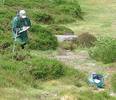National Parks & Biodiversity on Paths
Stage 3: How to carry out the investigation.
Method 2: A line transect using a point sampling technique.
Apparatus:
- 25m measuring tape.
- x2 securing poles.
- Recording sheets.
- Clip board
| - Compass.
- Identification sheets.
- Digital camera
- Inclinometer to measure the angle of the slope.
|

 |  |
|
Point Transect in action - Click to enlarge |
Method
Line Transect
A line transect uses a measuring tape. The tape is run across the path (at right angles to the path) along the ground. It is held in place by two poles. Every 25 cms the species of plant touching the string is recorded. This is repeated from one side of the line to the other. Where there are no plants, bare earth is recorded. You may have more than 1 species at each point.
- At each point, the height of the vegetation is measured to the nearest cm and recorded.
- A sketch map is made of the area and a compass used to show the orientation of the transect.
- Because this method is very quick, the line is then moved to two further (or more if time) locations across the path. As far as possible, the lines should be at right angles to the path.
- The inclinometer is then used to determine the angle of the slope of the path over each sample area.
 Download a sample recording sheet
Download a sample recording sheet
Some practical points:
- Line transects using point sampling are very useful for assessing dense or overgrown habitats where plants overlap. In theory, you can get more than one species at one point.
- Point transects may miss the rarer plants.
- When this method was used it only took 15 minutes to complete, whilst the belt transect took nearly an hour.
 Stage 4: Handling and analysing the results
Stage 4: Handling and analysing the results




 Stage 4: Handling and analysing the results
Stage 4: Handling and analysing the results
What's your opinion?
Average rating




Not yet rated